#Sefirot Games
Text
kickstarter

The Hidden Isle is a pen and paper RPG that uses Tarot cards instead of dice, set in the 16th century on the secretive island of Dioscoria. It focuses on roleplaying and collaborative storytelling.
This is a game about swashbuckling adventures across Europe and the Middle East, stealing forbidden texts from oppressive regimes, protecting an island of outcasts using ancient magic, and toppling empires with just the right speech at just the right time.

If you are familiar with Tarot then The Hidden Isle will resonate with you all the more, but no experience with Tarot is necessary. To help you feel like a mystical oracle and stay inspired, we’ll provide you with tables and guides to help you quickly understand each card draw.

Narrative heavy, rules light. While the game does have rules, their purpose is to enrich and drive your narratives. The game is designed as a collaborative storytelling experience.
Play and character growth intertwined. Each character has a burden—an emotional weight they carry—and an ideal to live up to. Become your truest self, or succumb to your worst impulses.

A vibrant 16th-century world. Dioscoria is described in loving detail, as are major cities of the time such as London, Istanbul and Venice. No historical knowledge is needed.
A wide array of characters. Play as an Illusionist, Scoundrel, Occultist, Prowler, Champion or Hunter. More characters are planned for stretch goals.
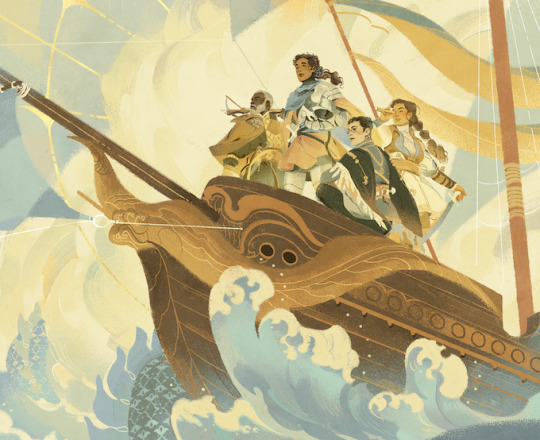
GM can plan or improvise. Scenarios can be planned ahead of time by the Seer, or improvised at the start of a session for GMs short on time.
Tarot cards instead of dice. They’re used for everything from scenario inspiration, to character backstories, to divination, to skill checks. No Tarot experience is required. Any deck can be used, but we recommend the Sefirot deck.

Dioscoria: a hidden isle of sages, adventurers, and ancient wisdom. Within the walls of this secret city are gathered the misunderstood, the persecuted, those unjustly punished for the way they live. Here they can flourish, and return to the world to wage their secret war against injustice and ignorance when they are ready.
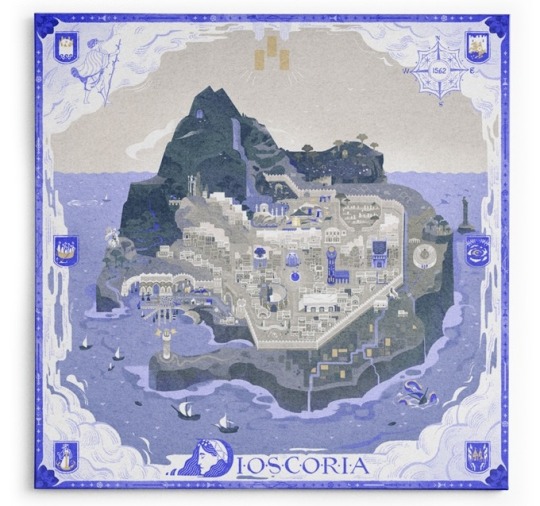
1562: It is a dangerous and disrupted time. Europe has embraced the innovations of gunpowder, and is using it to tear itself apart along religious lines. The Ottoman Empire is poised to break either Vienna to its west or the Safavid Empire to its east. European colonisers are spreading along the coastlines of the world like a hungry parasite. The Inquisition accuses, tortures and executes its victims across the Catholic world.
It is also a world of alchemy and sorcery. English magicians pry the mysteries of the stars. Ottoman scholars unravel the hidden design of the creator. Dioscorian mystics have mastered techniques to peer beyond the veil of time, and steer the world towards sanity.
Into this maelstrom step the agents of Dioscoria. Dioscoria's actors, magicians, assassins and paladins stand ready to defend the helpless and preserve wisdom. As these agents tackle scheme after scheme, and topple tyrants, cults and demonic forces, will they live up to their ideal selves, or embrace the darker parts of their own humanity?

Character generation: Characters’ backstories—their childhoods, their adult life, their emotional burdens and their ideals—are generated by consulting the Tarot for inspiration.
Burdens and ideals: Every character has a burden and an ideal. These are habits that threaten to engulf you, or values you are striving to live up to. Use them during play to make challenges easier, or become the person you want to be.
Skill checks: The Agent and the Seer each draw a hand of cards, based on the Agent’s skill and the challenge’s difficulty. Each plays a single card; the highest wins. The suit’s skill (swords, wands, cups or pentacles) acts as a trump suit.
Fortune cards: To avert failure, Agents may spend a fortune card to turn a failure into a success. Agents can jump in and help each other when all seems lost.
Solo mode: A favored Stretch Goal has been reached. Now you can play as an Agent in solitaire mode. The Cabinet of Extremis has chosen you to carry out their will on more dangerous missions than regular Agents undertake. You can also find the preliminary rules among the playtest materials.
Visions: Each Agent is blessed before each mission, and can receive glimpses of the past, present or future. Visions can be used to gain useful information, peer into a character’s fate, or add tension and stakes to a scene.

Harm: Harm can be physical or spiritual. Agents are usually harmed because of a failed challenge. Harm can severely impede an Agent, and lead to permanent trauma if untreated.
Abilities: Each character class has unique abilities. Occultists can curse with the evil eye. Performers can imitate their target perfectly. Hunters can spread panic by dispatching their enemies from the shadows. Just make sure your ability isn’t causing you more harm than you can tolerate!
Contacts: Your friends and allies in Dioscoria can help you grow. These personal connections help you train, prepare and reflect on yourself, and can teach you abilities you would otherwise never have access to.
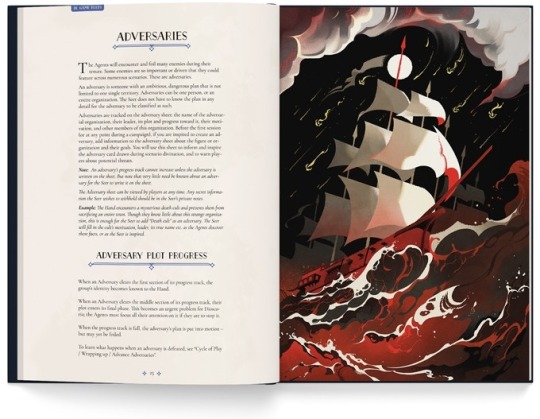
Territories: Dioscoria, and other cities, change over time: in response to player actions, or inspired by Tarot draws. This can create a unique geopolitical landscape: a world that branches off from our own history.
Scenario divination: For GMs who don’t want to prep ahead of time, scenarios can be generated on the fly by drawing Tarot cards and consulting the “Vision guide”. If you chain these scenarios together, you can generate entire campaigns with nothing more than a Tarot deck and a little imagination.
The Hidden Isle is inspired by Forged in the Dark, and its core is formed from that system’s style and dynamics. However, this is not just a reskin with Tarot cards: The Hidden Isle is an original and coherent game with its own feel and rhythm.
Play The Hidden Isle now!
If you’re curious how the rules come together, and how it feels to play, why not try The Hidden Isle yourself? To get started, just download the playtest materials:
Download Playtest Kit
We also have two pre-made scenarios for you that can be played immediately:
The Rialto Scrolls: Rescue a scholar from the Jewish Ghetto before her life's work falls into covetous hands.
The Face of the Enemy: Foil a spy sent to Dioscoria to bring the island under control.
And if you don't have a group at the ready, try the game with the preliminary solo mode!
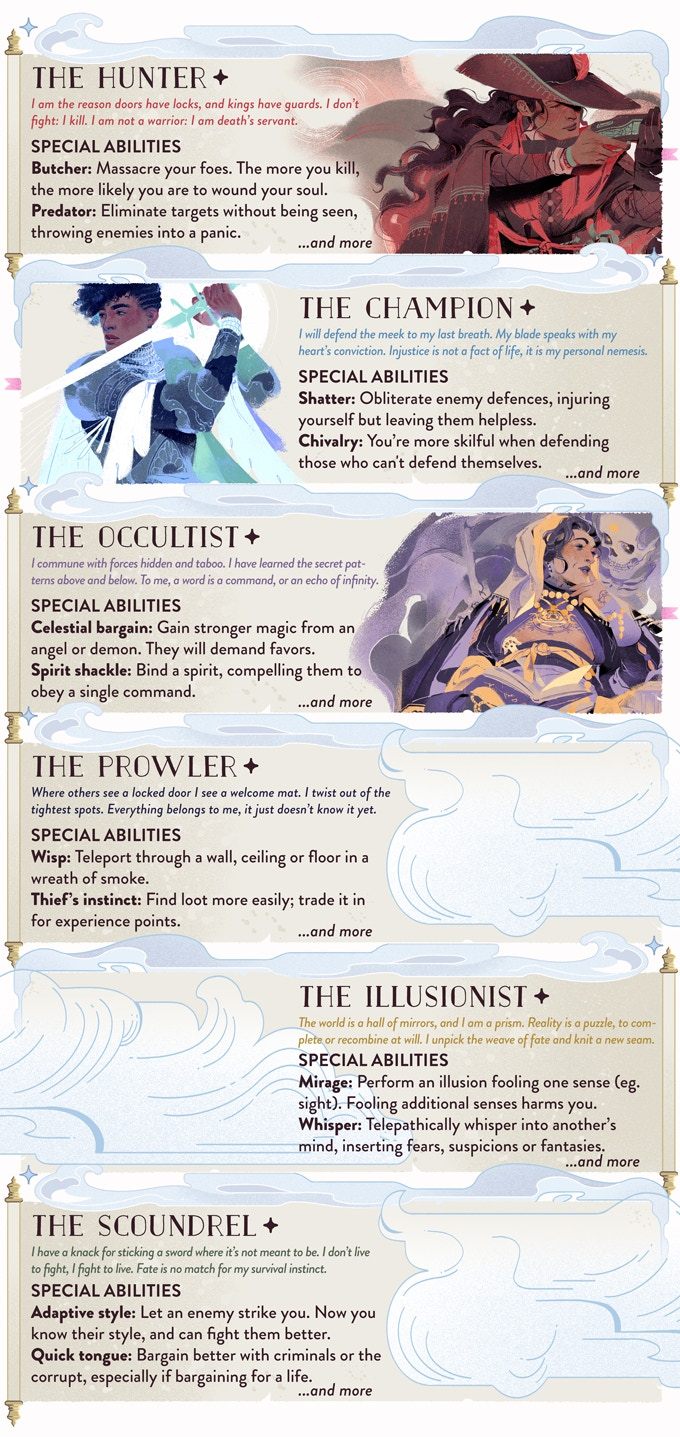

The Hidden Isle – an A4-size, gold-foiled, hardcover book of roughly 230 pages – contains the complete game rules, sections describing Dioscoria and the world of the sixteenth century, and all character classes and supplementary tables.

230+ pages of beautiful, elegantly laid out material. Bound in hardcover, clad in gold foil.
Complete game rules, including character creation, NPC generation and scenario generation using Tarot cards.
Five classes, each with eight unique abilities!
A flexible magic system featuring seven schools of magic and seven magical sources.
33 specialized items for your Agents to draw on during each mission.
24 historically inspired magical creatures.
A full, dedicated chapter on Dioscoria: its culture, origins, and a tour of the city.
A practical "Advice for Seers" chapter, giving you extra tools to help you run a game of The Hidden Isle.
A detailed section on the world of the sixteenth century,containing extensive lore on five major cities of the time, from various parts of the known world.
Tarot tables and references to help you understand any card, giving you multiple prompts for any situation to aid inspiration.
Additional materials for printing at home such as character sheets, reference sheets, Tarot tables are available via digital download.
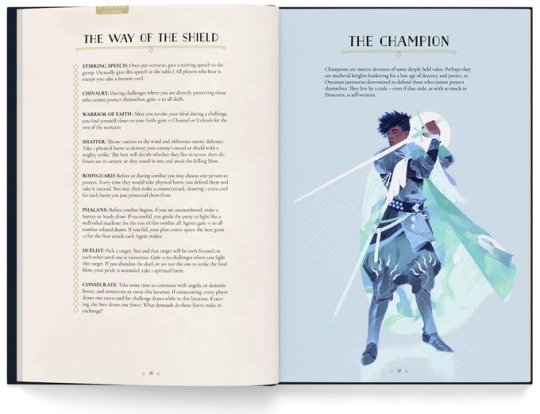
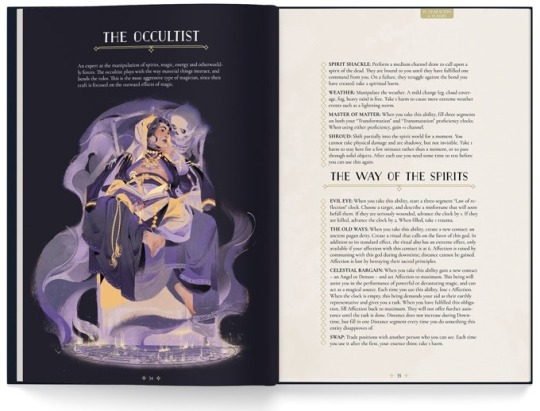
Kickstarter campaign ends: Sat, October 28 2023 3:55 PM BST
Website: [Causa Creations] [Sefirot Games] [facebook] [twitter] [instagram]
164 notes
·
View notes
Text

The Hunter's Handgun
1 day left to support The Hidden Isle 🏝️
#artists on tumblr#illustrators on tumblr#kickstarter#the hidden isle#sefirot#sefirot a tarot board game#item illustration#ttrpg#item art#wheellock pistol#wheellock gun#fantasy art#fantasy item
751 notes
·
View notes
Text
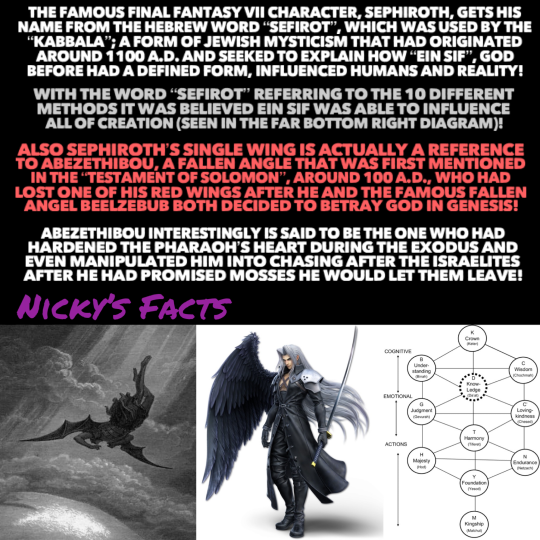
All hail the Jewish Heartthrob of Darkness!
🖤🗡🖤
#history#sephiroph#sefirot#final fantasy vii#abezethibou#video games history#kabbala#judaism#one winged angel#ff7#abrahamic religions#jewish history#exodus#square enix#super smash bros#super smash bros ultimate#christian history#jewish folklore#testament of solomon#jewish mysticism#video game inspiration#final fantasy 7 remake#fallen angel#video games#villain#ssbu#nickys facts
19 notes
·
View notes
Text

Ace of Wands: Heat, creativity, momentum, expulsion of blunt energy force. Circumstances in bloom. Project in bloom.
Queen of Swords: The logical thinker, and gifted analytic. Enforcer of boundaries, distant from others. Going online.
King of Swords: Analytical man of high mental caliber. A mind with calculated intentions. A restless and at times tormented mind.
King of Cups: A loving man of sensitive nature. Prone to enjoy music in harmonious environments. Enjoys seeing everybody around him get along.
Two of Cups: Loving mirror images of one another.
Knight of Swords: Events happening quickly. Days passing quickly. Many conversations had over a short span of time. A surprise visit.
Pain for the man, unexplored mental paths for the lady. Events flowing in motion.
#free tarot reading#free tarot readings#daily tarot#tarot community#tarot cards#sefirot game#sefirot tarot#spheres of heaven tarot#tarot#tarot deck#tarotblr#tarot reading#free tarot#divination#tarot diary#advice#cartomancy#tarot spread#tarot reader#tarot tips
28 notes
·
View notes
Text
It's been a few months (at least a year I think?) since I preordered a Tarot game and today it finally arrived!
I didn't plan for this to happen, but the new guide I recently mentioned? He basically claimed that game and demand to communicate with me through it. Which, I have to admit, fits him very, very well. I really like how certain things come togerther.
Anyway, I gave the game a test run without him to get a feel for its energy and how well I'm able to read Tarot through it. I've tweaked it according to my needs because luckily the game itself mostly leaves it up to the reader how they want to read – if at all.
That test run? Yeah. That'll work. Nearly too well considering it's been the first time.
#tarot#tarot community#tarot readers of tumblr#witchy queue#chapter: journal#topic: spiritual practice#sefirot tarot game
7 notes
·
View notes
Note
How do cards gain meaning in an occult sense? Like, both tarot and french-suited playing cards started as game pieces, but they have gained an understood meaning. Is it just someone whips up an organized table of connected ideas or is each card interpreted from a certain framework?
Oh good question!
Many things that we now consider staples of western magic are ideas that have been added to over generations by several layers of thinkers. Tarot Divination specifically is an excellent example of this!
In 1770, A french printmaker and occultist going by Etteilla published a book about how to do cartomancy with a 32-card Piquet deck. He writes down some simple but strict associations for the cards, and makes what is probably the first mention of reversals in carotmancy. He said that he learned the system "from an Italian." Now, its unclear how much of the system is his own invention, people have been doing cartomancy for as long as there's been cards, but the text presents a larval, bare-bones version of the cartomancy methods we know and love today.
Its 1780-ish. The Rosetta stone hasn't been discovered yet. Occult-inclined Europeans are obsessed with Egypt. That's where our boy Trismegistus is from! There's a concept in Egyptian mythology called The Book of Thoth, a mythical book of spells penned by the God of Knowledge himself. This was the Holy Grail for European Occult Egpytaboos.
In 1781, Antoine Court de Gébelin claimed that Tarot cards were the "original book of Thoth," Saying that Tarot cards had been used by ancient Egyptian priests for their own magical ceremonies, and that their designs contained ancient mystical secrets. This is 100% not true, but he writes a pretty fun pseudohistory for Tarot that involves Romani people bringing the decks to Europe through the Levant where they then taught its esoteric secrets to several Popes.
Then in 1783, Ettellia responded with another book. Manière de se récréer avec le jeu de cartes nommées tarots ("Way to recreate yourself with the deck of cards called tarots") Where Ettellia basically claims "uhm actually I knew about tarot divination way before Court de Gebelin published that big ass book. But anyway here's an interpretation of Tarot symbology that includes multiple references to Egyptian, Zoroastrian, and Greek mythology." But the smartest thing he did was include spread methods that involved Thoth and Numerology. Napoleonic Occultists fucking loved Thoth and numerology.
In 1788, he formed a little magical society for the express purpose of discussing and workshopping ideas for Tarot divination. In 1789, he made a TRULY smart decision, and published a Tarot deck that was Specifically For Magic, and that basically cemented Tarots place in magical history.
Occultists just kept iterating! Someone would speculate "maybe the suits correspond to the elements" and people went "yeah, they correspond to the elements! That makes this tool even more fun and interesting to use!" Then people go "What if the suits and the elements also correspond to parts of the Self?" and people went "Sure they do! That makes this tool even more interesting!"
But its also not just one thread. Eventually you get the Golden Dawn saying "The Major Arcana correspond to the nodes and paths on our version of the Quabbalistic Sefirot, you know, the hermetic version with a Q." and some occultists responded "Idk about that! Love what you've done with the color symbology though!"
The development of magical ideas is an iterative process. It is people whipping up a table of correspondences, but that table needs a mythology to keep it together. Originally, the mythology that gave tarot "power" was its Egyptian pseudohistory, but these days its the fact that occultists have been iterating on and fine-tuning this system for hundreds of years.
Humans don't think in tables of information, they think in stories. The cool thing about stories is that they're flexible. If magic is anything, its learning how to engineer stories to make the tables of information more effective.
I'm gonna plug my patreon where I post all of my occult research if you wanna see more stuff like this
#Tarot#Occult#I was supposed to edit today but I couldn't pass up this opportunity for a micro essay#cartomancy
3K notes
·
View notes
Text


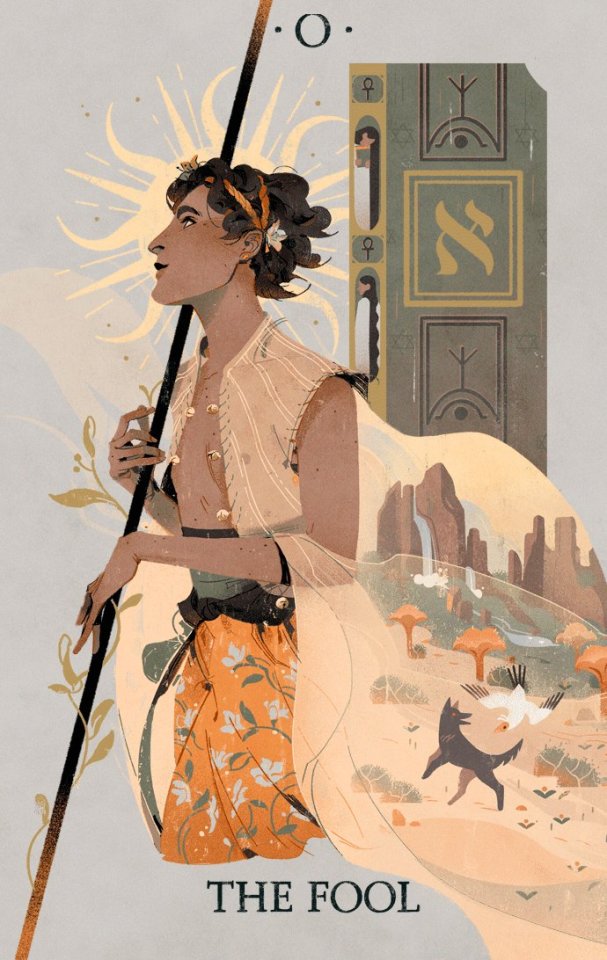

You can now get a copy of the Sefirot deck, the game, pins and more until the end of February ✨
#sefirot#tarot#tarot art#artists on tumblr#illustration#death#the fool#knight of pentacles#knight of swords
5K notes
·
View notes
Text
Kabbalah in the Worldbuilding of Genshin Impact; Part 1: The Tree of Life, the Universe, and Everything
Edited for clarity, 12/6/23
Written by Schwan (@abyssalschwan on twitter) and Sabre (trashcanlore, @paimoff on twitter)
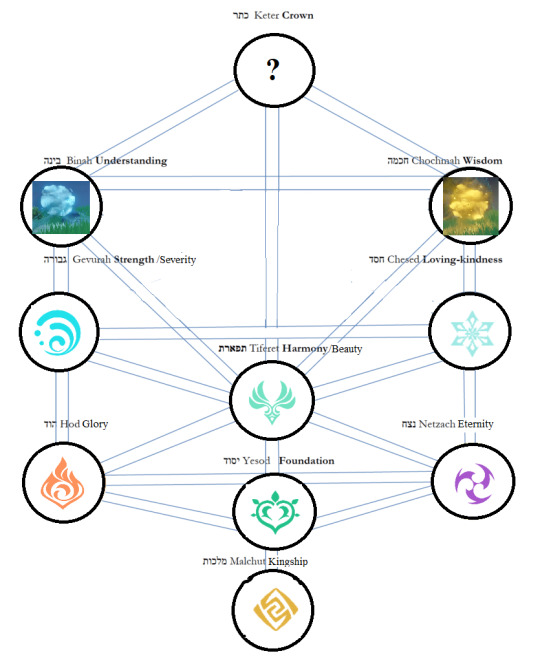
During the Sumeru Archon Quests, we learned that the Irminsul is a (real! (ish)) tree that grows upside down, seemingly underground, and that the roots of the tree are the Ley Lines, which extend throughout Teyvat and the Abyss. Irminsul stores all knowledge and memories in the world, and the Ley Lines are the mechanism by which the tree acquires this information. Ley Lines move elemental energy through Teyvat, and this energy acts as both a storage medium for information but also a resource that can be utilized for combat, alchemy, an energy source (Azosite), etc.
The origin of the name Irminsul (unique to the Western localizations) in combination with the many names from Norse mythology associated with Khaenri'ah, suggest that the inspiration for Irminsul is Yggdrasil, the world tree and central axis of the cosmos in Norse mythology. Here we propose an additional inspiration for Irminsul and the associated worldbuilding and elemental system of Teyvat: The Kabbalistic Tree of Life. In this model, Teyvat’s elemental energy is comparable to the creative energy described by Kabbalah as the foundation for the creation of reality and the spiritual world. Specific attributes of elemental energy can be channeled by unique individuals in Teyvat and these attributes manifest as distinct elements, which can be directly compared to the 10 sefirot, or emanations, described in Kabbalistic literature.
What is Kabbalah?
Kabbalah (lit. received, tradition) is a school of thought originating in Jewish mysticism. In general, Kabbalah focuses on the relationship between the infinite (God) and the finite universe and how it was created. The goal of studying this mysticism can vary depending on the school of thought and their motivations. Many of the esoteric and religious influences on Genshin lore and worldbuilding were influenced by Kabbalah, or vice versa. These include Gnosticism, Hermeticism, alchemy, Freemasonry, the occultist branches of Theosophy and Thelema (Golden Dawn), astrology, symbolic interpretation of the tarot (also specific to the Golden Dawn) and more [2]. In short, Kabbalah is everywhere. Additionally, its concepts are used as symbolism in several pieces of media that directly or indirectly inspired Genshin and other games in the Hoyoverse.
If you have frequented Genshin lore topics, you might have heard that one of the main sources of inspiration for its worldbuilding is Gnosticism. The problem is, Gnosticism is a bit vague or contradictory when it comes to how the world was created and how the whole existence thing works. At this current moment in the storyline of Genshin, we have very little information on the very beginning of existence in Teyvat. This information seems to be a crucial part of the “truth of the world” and appears to be purposefully hidden by powerful factions like Celestia. This entire theory was born out of trying to make sense of what little we know about the creation of Teyvat and comparing it to esoteric commentaries on the well known creation myth of the Torah (Old Testament). The “Biblical world structure” interpretation of Teyvat has been around since the early days of Genshin lore and with good reason; there are frequent mentions of the firmament, as well as the name Teyvat sounding very similar to the Biblical Hebrew word for ‘ark’ (although the grammar is a bit mangled). There are also several references to stories from the Bible in in-game texts, including Before Sun and Moon.
Kabbalah literature spends a lot of time trying to understand and describe the process of how the world was created and the underlying principles of reality, as well as how spiritual practice can change that reality (either metaphorically or literally). Kabbalah intends to describe the “true nature of God,” which is equal to the entirety of existence, as something very vast and completely impossible to grasp. This incomprehensible infinity emits an “limitless light” that is the origin of all creation. Elemental energy (the ubiquitous source of everything in Teyvat) is often found compared to light, something we’ll discuss in more detail later. The “limitless light” of Kabbalah is way too powerful for existence to bear, much like how elemental energy is to normal, non-Vision having humans. That’s why this light needed to be “filtered” down. This happens through the process of creation, which passes the light through the spiritual attributes that form the Tree of Life, which is like a sort of diagram for how the universe came into being [3].
The Tree of Life
The tree of life and its 10+ nodes, known as sefirot, is one of the most well-known concepts from Kabbalah to make its way into popular culture. As mentioned previously, the tree has been used as rule-of-cool symbolism in anime such as Neon Genesis Evangelion and Fullmetal Alchemist, two pieces of media that likely are significant influences on Genshin (If you doubt that HYV loves NGE, play some Honkai). The sefirot are also depicted on the floor of the Schicksal HQ map in Honkai Impact 3rd, for some reason.
The sefirot and their organization and interactions with each other can be found depicted in many ways, such as the tree format that is the most popular, or a spiraling nested scheme that is really cool, or even very stylized, like the work of Robert Fludd.

Sefirot
Sefirot comes from the root word in Hebrew meaning “to count,” but you can also find it translated as “sphere” in some texts. The term originated in a book on Jewish mysticism called the Sefer Yetzirah, or “Book of Formation/Creation.” which describes the combination of the “sefirot of nothingness” and the 22 letters of the Hebrew alphabet as the foundation of reality (remember the hypostasis codenames?).
The Sefer HaBahir (lit. the book of brightness, 13th century France) introduces the idea that the sefirot are emanations of the divine. Interestingly, this book refers to the sefirot as ma’amarot (sayings), which builds on an important concept in classical Jewish philosophy – the idea that God spoke the world into existence. [We’ll get back to the Sefer Yetzirah and the role of language in creating the world in a subsequent part of this theory]. Fontaine 4.2 era edit: HELL YEAH stay tuned for more about Oceanids!!
Historically, Kabbalah might have taken this rough concept from a very different school of thought: Pythagoreans or neo-Platonists. Briefly, the connection between the Pythagoreans and the Kabbalistic sefirot is that both groups considered the world as being made of numbers. This ties back into Genshin worldbuilding because of how much Platonism is related to Gnosticism. Something else to keep in mind is that Pythagoreans (who had a cool history that connected Egypt and Greece to the magic of ✨math✨ but also hey Genshin lore hello Deshret) were known to use lyres as their instrument of choice while making mathematical studies of music. More sus Venti lore for the collection? This is also interesting to consider in the context of Nahida, who is deeply connected to the Irminsul, and has animations that are reminiscent of computers.
Later in the 13th century, the Kabbalist Isaac the Blind would 'canonize' the list of sefirot (there’s still some variation to this day) and organize them into a sequence that would become the basis for the famous Tree of Life structure. His writings described the sefirot as attributes of the divine and their role in the creation of the world. In his model, the sefirot originated from lights that emerged from a primordial soup of potential, and these sefirot/lights would then ‘flow’ and emanate into each other. His student, Azriel of Gerona, expanded on this with a neo-Platonic lens and introduced the concept of the Ein Sof, the infinite nothingness that cannot be comprehended and is the origin of everything. In this model, being flows from an infinite resource of potential, which the divine can utilize through the framework of the sefirot, eventually creating the world [4]. In simple terms, the Ein Sof, which contains everything, emits a primordial light that then differentiates into the sefirot. In our Genshin analogy, this primordial light would be like extremely pure elemental energy that differentiates into elements, like light passing through a prism.
Moses Cordovero, an important figure in the development of Kabbalah, described the process of the sefirot differentiating with the analogy of light shining through a stained glass window:
Imagine a ray of sunlight shining through a stained-glass window of ten different colors. The sunlight possesses no color at all but appears to change hue as it passes through the window. The light has not essentially changed though it seems so to the viewer. Just so with the sephirot. The light that clothes itself in the vessels of the sephirot is the essence, like the ray of sunlight. That essence does not change color at all, neither judgment nor compassion, neither right nor left. Yet by emanating through the sephirot -- the variegated stained glass -- judgment or compassion prevails. (Pardes Rimmonim by Moses Cordovero, translated in Essential Kabbalah by Daniel Matt)
Cordovero considered the sefirot to be completely independent of each other, but the later Lurianic school of Kabbalah (we’ll get into them more in later parts) considered the sefirot to be constantly dynamically interacting with each other and also assigned them personas.
Achievement grinders amongst us may recall the descriptions of the namecards you get upon completing the Elemental Specialist achievement series:
Achievement: Colors of the Rainbow: Light can refract into countless colors, but people stop at seven because they're too lazy to count. Perhaps the elements are like that, too.
Achievement: Seven Lights: Anyone can play a tune that belongs just to them, and like the dew under grass, can reflect the seven lights of heaven.
Another example of the elements being compared to light is the Latin text found on the magic circles on the door of Mona’s future house in Mondstadt and generated by the hypostases during their missile attacks. The text reads:
Ex culmine lucis in magno elementorum, which translates to "From the peak of light, to greatness of the elements."
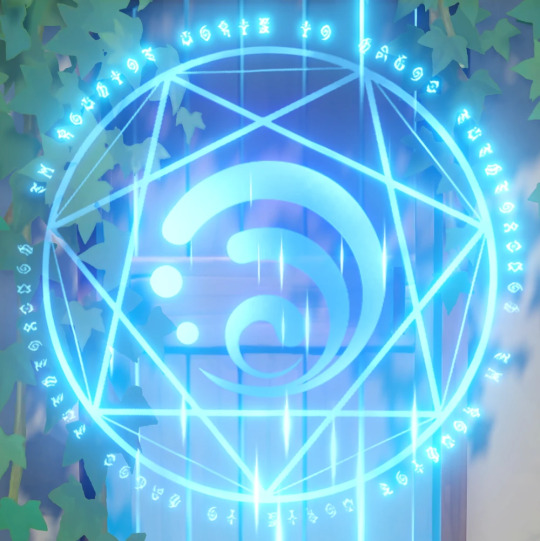
It’s interesting to see this text appearing in association with the hypostases since they are described as “life forms which have completely abandoned their former appearance and biological structure, making them able to reach the highest level of elemental purity. They are ultra-compact structures with a high mass, and are the highest forms of elemental structures.” The hypostasis code names are also all Hebrew letters, as mentioned earlier.
Mona’s astrolabe during the Unreconciled Stars event features a similar text:
Ex culmine locis in magno elementorum; Lux se effundat in mentes dei, which translates to "From the peak of light, to the greatness of the elements; May light pour out, into the minds of god."
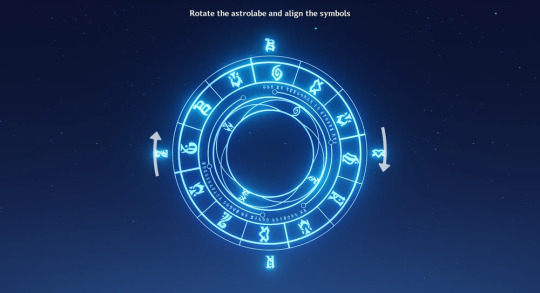
The Abyss Lector catalysts contain a text that mirrors these two examples:
Ex culmine lucis in mango obscuritas. Lux se effundat in mentes abysso, or “From the peak of light, to the greatness of darkness. May light pour out into the minds of the abyss.”
The Genshin elements are also described as flowing. For example, a loading screen tip specifically describes the Ley Lines as “A mysterious network that links the whole world together, within which flow the elements.” The Silver Twig description states: "All knowledge, memory, and experience flow through this giant tree, just like a stream flows into a river, the river joins a sea, the sea turns into clouds, and the clouds rain onto the ground — just like life itself."
Sefirot and the Genshin Elemental System
The 10 (sometimes 11) sefirot are:
Keter: Crown (this one is even more symbolic that the rest, is described as “the most hidden of all hidden things" in the Zohar, represent things that are above the mind’s comprehension and the very beginning of the process of turning potential into reality)
Chokhmah: Wisdom
Binah: Understanding/Reasoning
(Da’at: Knowledge, as a fusion of Chokhmah and Binah)
Chesed: Loving Kindness or Mercy
Gevurah: Strength/Severity, (sometimes Din, Judgement, or Pachad, Fear)
Tiferet: Beauty/Harmony, is associated with balance of the Tree of Life
Netzach: Eternity/Endurance
Hod: Splendor/Glory
Yesod: Foundation (as in, foundation of reality)
Malkhut: Kingdom/Sovereignty
You’ve probably noticed by now that while we are claiming that the concept of the sefirot applies to the elemental system in Genshin, there are 10 sefirot and only 7 elements (for now). Fortunately for us, the Kabbalists love metaphors and categories. In addition to the sefirot representing the procedure used to ‘emanate’ and create the world, there are other methods of interpretation that further subdivide and rank the sefirot. For example, one metaphorical interpretation of the Tree of Life assigns each of the sefirot to a part of the human body.
In some Kabbalistic traditions of interpreting the tree, the 10 sefirot are divided into two categories: Intellect (Keter, Binah, Chokhmah) and Emotions (they’re actually more like character traits), which contains the remaining seven. These categories are meant to parallel how the soul is also divided into the intellect and emotional components. The first three sefirot are also referred to as the “three mothers,” because they are the source of the lower seven [5].
Having a group of seven sefirot is very convenient for comparing their traits to the elements and their ideals, but what about the role of the higher three in Genshin worldbuilding? This next section requires a bit more conjecture than some other comparisons here.
The source of all elemental energy in Teyvat, whatever that actually is, could be compared to Keter (crown), the most hidden and incomprehensible of the sefirot. (Big stretch, but think of the crowns over the Irminsul trees in domains.)
Next, we have the Ley Lines, which contain dreams and memories (these are basically the same in Teyvat, see Dream Solvent description), and these can be compared to Binah (understanding/reasoning) and Chokhmah (wisdom). During the Sumeru Archon Quest, Rukkhadevata says that dreams are the source of the wisdom she upheld as her ideal. Memories play an important role in discerning the truth of the world, as the traveler has now found themselves to be the only person to remember certain people/events, and has been told to trust their memories rather than what they can see.
Comparison of the 'Lower' Sefirot to the Genshin Elements and Their Ideals
Chesed (loving-kindness); Cryo (unknown, theorized to be love)
The Cryo Archon’s ideal is theorized to be love, as it’s the only characteristic mentioned in relation to her in the Travail trailer. Wanderer’s voiceline about her directly mentions love and describes her as being kind and benevolent, while Childe describes her as extremely gentle. These are the characteristics of Chesed, which represents the trait of completely selfless love: the all forgiving, all giving love of a god towards their creations. When it comes to the Cryo element itself, two things are worth mentioning: one is the way that all of Snezhnaya is perpetually covered in snow, as if this were the (ironic) physical expression of the Tsaritsa’s love blanketing them. The second is the promise of a world-encompassing snowstorm that will envelop everything as the Fatui advance on their war against Celestia. Although it’s hard to find one absolute constant in Vision granting stories, it’s notable that most Cryo users got their Vision at a moment when they had to selflessly be there for others (Diona, Chongyun, Mika), or after a decisive moment where they put aside their personal comfort for an ideal that would result in benefit for others (Kaeya, Eula, Layla).
Gevurah (Severity); Hydro (Justice)
Gevurah is associated with divine judgment, the kind that punishes humanity and causes world-altering catastrophes like the flood or the expulsion of Adam and Eve from the Garden of Eden. The Hydro Archon organizing her nation around a Court that attempts to judge both deities and humans parallels this. In a more positive sense, Gevurah is also related to moral judgment that allows one to tell good from evil. Likewise, Hydro in-game is often associated with purity and separation of clean and unclean matter. When it comes to Hydro Vision wielders, one common characteristic is that they all live by a personal ethical code, and their commitment to it is what granted them their Vision.
Tiferet (Beauty/Harmony); Anemo (Freedom)
Tiferet balances the other sefirot on the tree and has direct connections to almost all of them (except for Malkut). Similarly, Anemo can facilitate many elemental reactions via its Swirl reaction. In our opinion, something almost all the Anemo characters share is that their moment of receiving a Vision coincides with a moment of balance and harmony with themselves or their environment. See Jean and Kazuha’s Vision stories and the cutscene where Scaramouche/Wanderer gets his Vision. As an aside, comparing harmony to Anemo is funny because Venti is a bard and harmony is also a musical term: in music theory, harmony is the way we analyze the interactions between different voices that can be heard at the same time.
Netzach (Eternity); Electro (Eternity)
The quality of “Eternity” in Netzach is related to victory against enemies, referring to eternity as being the most powerful combatant remaining among defeated adversaries. Likewise, in Genshin the story of the Electro Archon features many battles during the Archon War where Ei and Makoto ended up victorious. As for Electro users tend to have their Vision granted at a moment when their ambition “defeated” the obstacles of reality, as was the case with Fischl, Kuki and Lisa. Cyno’s Vision story makes sense when you compare it to the illumination of Buddha during meditation, and how this was victory over the temptation of the demon Mara.
Hod (Glory); Pyro (War)
Natlan and its Pyro Archon are possibly the most mysterious of all the regions, so we can only speculate. We know that the Pyro Archon is called the God of War, and that the Pyro Gemstone mentions battles, pilgrimages and truth. The sefira of Hod, translated as Glory or Splendor, is linked to being able to connect with God and therefore also associated with prophecy (as in the way a human can carry a message from God). In the Travail trailer, the Pyro Archon tells the traveler that “the rules of war are woven in the womb.” It's also theorized Natlan will be based on Mexica culture (where sacrifice of both enemies and self sacrifice was a way to connect with the gods) and via Iansan's name, the Caribbean diaspora version of Yoruba religion (where many rites involve the gods making themselves present in the material world).
Yesod (Foundation); Dendro (Wisdom)
Back when we started to think about this theory during version 2.8, we decided on Yesod largely via process of elimination. One piece of our rationale was that in the Jewish tradition, each of the lower seven sefirot are used to represent a primary personality trait of seven archetypal figures in the Torah. The person related to Yesod is Joseph, who is well known for his prophetic dreams, and because of the events of the Golden Apple Archipelago, we decided that was close enough. However, the 3.x version confirmed that a) Irminsul did actually exist, b) Dendro as an element has a deep relationship with the tree, with the Dendro Archon acting as its avatar, c) the ideal of wisdom as both Dendro Archons interpreted it has a lot to do with dreams, and d) Irminsul and the Ley Lines act as the foundation for how reality is perceived in Teyvat. Yesod is also associated with biological life, as it represents the reproductive organs in the human body scheme of the sefirot.
Malkut (Kingship); Geo (Contracts)
Malkut is associated with the connection between the spiritual "above" of the Tree of Life and the concepts it contains, and the "below" of the material world, where these concepts manifest into material reality. For this reason, Malkut is associated with the earth [6]. In many Geo item descriptions, like the Geo Hypostasis drop or Albedo's elemental skill, the motif of geo trying to reach the sky is a constant. From a religious POV, the relationship between the divine and humans living in the material world has also been one of "covenants," or "pacts", in a similar way to how the Geo Archon is the God of Contracts. Furthermore, contracts are the basis to have a working state (government), and a kingdom is one of the first forms of a state. Malkut also being related to earth and everything material parallels how Geo is an element that works in making constructs. Geo Vision users are likewise involved in making or maintaining structures, like the Knights of Favonius is for Noelle, or the tradition of alchemy is to Albedo, as well as opera to Yunjin and in a way, even the Oni identity for Itto.
The Origin of Evil and Why Irminsul is Upside Down
Tighnari tells us that Irminsul is a tree that “grows downward rather than upwards,” or in other words, it’s upside down. This isn’t the only time that we’ve encountered things in Teyvat being described as upside-down or mirrored, and as it turns out, there is a similar scenario described in Kabbalah. Throughout Kabbalistic discussions on the origin of evil in the world (both material and spiritual), a central idea developed is the existence of a mirrored or inverse Tree of Life that forms the demonic realm of evil. The Zohar, a foundational work of Kabbalistic literature, spends a considerable time discussing the origins of evil - there are more than 5 creation myths for the concept of evil! Two of these myths describe the formation of an inverse Tree of Life, called the Sitra Achra (literally “other side”). This tree is constructed out of corrupted fragments of divinity that did not make it through the creation process, and therefore became evil forces [7]. Evil is typically represented as either a shard (like of broken pottery) or as a husk/shell (Qlippoth in Hebrew). Sound familiar? We actually have an enemy with this name in-game; the "shadowy husks" (the CN name for these enemies literally translates to "empty shell").
Unlike the very well defined 10 sefirot of the Tree of Life, Kabbalists don't agree about the identities or number of the demons that form the Sitra Achra. Some names for these demons are consistent; such as Lilith, Samael, and Asmodeus, who make a sort of "mother, father, son" trio. As for the rest, scholars generally agree that Kabbalists blended traditions from nearby cultures depending on where they lived, leading to Arabic, Spanish and Germanic legends mixing into the Jewish tradition [8]. There's a strong possibility Hoyoverse did something similar and filled in the missing names with the names of the demons of the Ars Goetia, creating a system where the mirrored sefirot are “ruled” by demon gods, aka, the Archons. This implies that the reason Teyvat is upside down is because it is actually on the “other side.”
Neuvillette, About Us: Witness: Since you hail from beyond the stars, I invite you to be my witness as I judge this upended world…”Though we live in a world of disarray, I shall undertake to restore all that has been broken”.
[Fun Fact: The Zohar describes the construction of the Sitra Achra as a series of knots that arrange the demonic equivalent of sefirot, called either crowns or “breaths,” into a mirrored Tree of Life configuration [7]. ]
The primary goal of the Sitra Achra is to steal and absorb the divine energy of the Tree of Life to maintain its existence, in the hopes of gaining enough energy to destabilize the system [9]. The way Genshin's Archons use their Gnoses is similar to this system. In the Flower of Paradise Lost artifact lore, the Goddess of Flowers explains to Deshret and Rukkhadevata that when the Seelie race was disgraced, they lost their connection to Heaven and their power of "enlightenment". Later, Celestia would facilitate the Archon War with the promise that each winning god would be granted a Gnosis that would give them exceptional power. Both Nahida and Venti have described the Gnoses as being a very advanced tool that concentrates elemental energy. So far, Archons have had inherent elemental powers related to their nature, but when it comes to using large amounts of elemental energy through their Gnoses, they aren't creators but channelers of it, just at a much larger scale than humans who have Visions. Edit: and yes, there is the most recent revelation about the origin of the Gnoses that is extremely relevant to this comparison, but deserves its own space to be properly expanded on.
However, this doesn't mean Teyvat is condemned. Just as the Traveler has slowly been setting the chaos of elemental energy back into order (by, for example, returning the elemental Oculi to the Statue of the Seven, among many other things), so too is there a concept in Kabbalah describing the importance of righting the wrongs of the universe so that the sefirot are stable and creation is in harmony with the divine. This is called Tikkun Olam, or the repairing of the world.
Stay tuned for part 2 where we go into wayyyyy more detail about what this means for the Traveler's journey through Teyvat! 4.2 Edit: and of course will we will be talking about the most recent Gnosis revelation, as well as the Narzissenkreuz Ordo antics :D
References:
https://www.chabad.org/library/article_cdo/aid/170308/jewish/What-is-Kabbalah.htm
https://en.wikipedia.org/wiki/Hermetic_Qabalah
Kabbalah - Origins of the Sefirot and Tree of Life - Isaac the Blind Saggi Nehor & Azriel of Gerona
Mystical Concepts in Chassidism - Schochct, Jacob Immanuel, chapter 2
Mystical Concepts in Chassidism - Schochct, Jacob Immanuel pg 66-67, Tanya ch. 3
Rebbe Nachman of Breslov, Likutey Moharan I, 12:1 via Wikipedia
The Origins of the Klippot / Qliphoth & Sitra Achra in the Zohar - Kabbalah on the Problem of Evil
https://www.jewishvirtuallibrary.org/demons-and-demonology
9. Evil in Early Kabbalah - Emanations of the Left Hand Side - Origins of the Qliphoth / Klippot
#genshin#genshin impact#genshin lore#please tell me you get the joke in the title XD#the kids do not know about 42
379 notes
·
View notes
Text
Just finished Lobotomy Corporation. Damn. Just damn. This game has a sincere value to me that very little things can match. There are so many thoughts swirling through my head, but damn. I am speechless. I have also been given other thoughts from Angela’s radical decision. It’s so fascinating how the Sefirot are all able to realize who they are, but she isn’t. Thus she makes her choice.
God damn this game is one of my favorites ever and it’s just so much more than just a video game.
There are so many words to be said, but I’ll leave off with this.
Thank you Lobotomy Corporation, for changing my life.
38 notes
·
View notes
Note
wait i really should've asked beforehand, who is your favorite Sinner from Limbus? i haven't been caught up with lc news so I don't actually know whose cantos are coming out yet jaodiwajai
Hong Lu, Ryoushuu and Outis! Yes. You said singular. I said three. I cannot choose dude. Outis had been a background favorite since the first trailer but because she and Ishmael were the only literary sources I recognized at the time- it also helps her VA is the same as Binah's, who's my favorite of the Sefirot.
Ryoushuu jumped up from me being curious to me adoring her so bad that I needed to write fanfic over it after I read Hell Screen(I do reccommend it! Very short read took me like 30 minutes and I still think about it and the motifs of the tortured artist and the meaning behind the monkey and the painter sharing a name).
Hong Lu, while I kind of worried he'd be annoying based on his initial appearences, won me over very quickly with his charm and silly persona- oh, he's hard to write by the way, main reason I haven't posted any fanfic for him. I have a few snippets drifiting around of various IDs and situations, but I struggle writing him. (Outis doesn't have any fanfic from me mainly because I have no idea what to do with the lady. I love her but. Ma'am. I HAVE roleplayed as her before though.) I still think about the fact that he has the least lines out of everyone...
I also have a particular preference towards Heathcliff and Rodion, though I wouldn't call them favorites. Actually, when I saw that one ask game going around Milgramblr I was reminded about how much I DESPISED Gregor at the beginning of Season 2 because the fandom was all throwing aside Rosespanner Rodion to point him out. WOMAN IS RIGHT THERE. ARE YOU NOT JOYOUS OVER WOMAN?
Anyways, yeah! I can give the canto order real quick, since it's still technically a theory but. 6 out of 12:
Gregor(Canto 1: The Outcast)
Rodion(Canto 2: The Unloving)
Sinclair(Canto 3: The Unconfronting)
Those three make up the bulk of Season 1 - Orientation. Considering Gregor and Rodion's incomplete ends to their cantos though, it feels the two might get more.
Yi Sang(Canto 4: The Unchanging/Season 2 - Reminiscence)
Ishmael(Canto 5: The Evil Defined/Season 3 - Bon Voyage)
Heathcliff(Canto 6: The Heartbreaking/Season 4 - ???, releaeses March 14th, also known as White Day)
Don Quixote(Canto 7: ???/Season 5 - ???, highly likely to release Summer 2024)
Hong Lu(Canto 8/Season 6 - ???, highly likely to release Fall 2024)
Ryoushuu(Canto 9/Season 7)
Meursault(Canto 10/Season 8)
Outis(Canto 11/Season 9)
Faust(Canto 12/Season 10)
#limbus company#I've been hanging around the corners of the pm fandom since right before Limbus Company's initial trailer dropped#I just. Didn't have twitter so I just get jumpscared with the trailer one day. And the Mili song.
19 notes
·
View notes
Text
omer counter 5783
Posting 6 Apr 2023 / 15 Nisan 5783: tonight starts the omer! You can check out HebCal's handy checker for what day of the omer it is at this link.
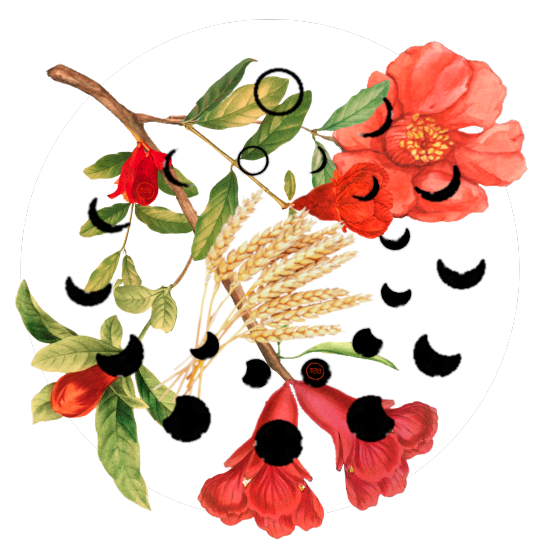
Image description: a digital collage with full colour botanical illustrations. A flowering branch of pomegranate has a sheaf of wheat in the middle. A spiral of moon phases in black starting from center top and ending with a gibbous moon at the straw for the sheaf of wheat.
For some people, this is something they were never taught about and you'll be surprised to hear about it. For others, it's a quotidian count without much more. For others (like me), it's a chance to do a little study each evening and take stock of your actions between Pesach and Shavuot. (Same goes for Shavuot - maybe it's a day you look forward to for study or for cheesecake, maybe it's something you never heard about. I like it because it brings together multiple of my loves: cream-based desserts, reading, flowers, and staying up all night.)

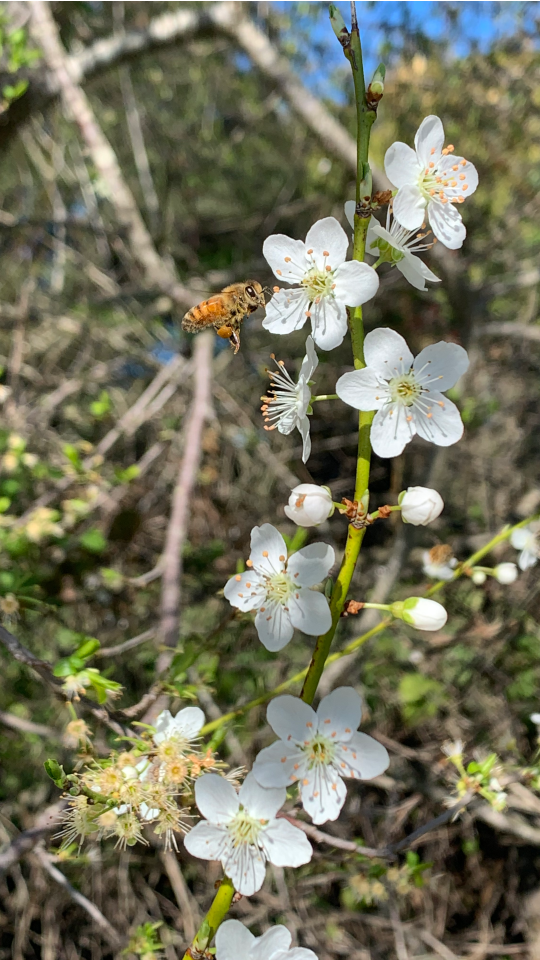
Image descriptions. Two photographs. Left is a single particularly tall stalk of blooming wild radish in a field of blooming white radish. The horizon shows some trees and the top third of the photo is a clear blue sky. Right is a bee about to collect nectar from a branch of flowering white ornamental pear. Her legs are visibly packed with golden pollen. The background is bokeh branches with few leaves on a sunny day.
The kabbalists introduced the practice of considering seven of the sefirot on the tree of life over the seven week period between Pesach and Shavuot as we metaphorically journey from the Narrow Place to Revelation. Each week has a sefira and each day has a sefira, so you end up considering each of them within each other: what does lovingkindness within discipline look like? What is sovereignty and humility within splendor? What is splendor within sovereignty?


Image description. Two images almost the same. Both depict a white kabbalistic tree of life collaged on a photo of the sea and mountains on the horizon at sunset with a subtle trans pride palette. The left has only Hebrew and the right has English transliteration under the Hebrew.
I have counted for a couple years now in chevruta and learn something new about myself, my friends, and our texts each year. If you've never tried counting before but are game to take a look, if you've tried before but this year you're going to complete it, or you've done this before and are looking to consider your practice from another angle, I have a tool for you!
I wrote an omer counter off my notes. We will never achieve full understanding, and each year will change and our understanding with us.
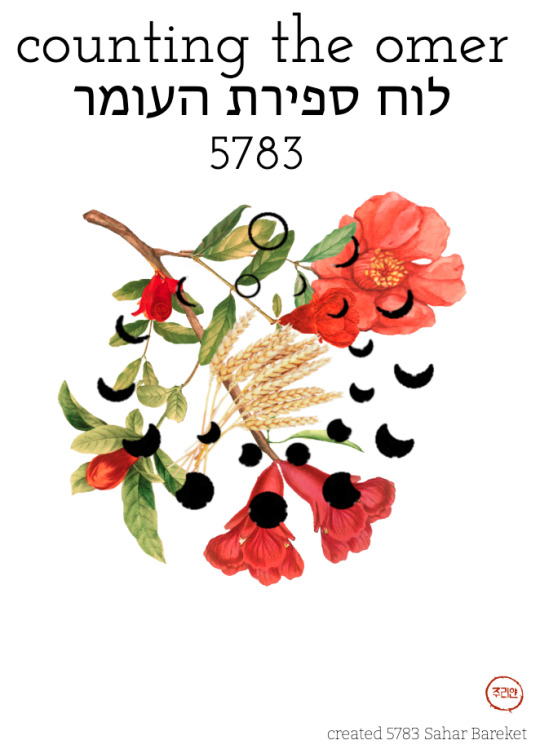
Image description: the cover of the omer counter with previously described pomegranate spiral moon and wheat image at center. Top reads counting the omer in English and Hebrew with the year 5783. Bottom right has artist signature in Korean and English transliteration of Hebrew.
There's a big at-a-glance spread of the count:


Image description: a double spread, split into two images, in black and white of a calendar with Gregorian and Hebrew dates, day of the count, sefirot, moon phases, and Jewish holidays.
There are quick breakdowns that invite you to consider your own systems and give background for
why and how to count
the tree of life
sefirot etymology and translations
what Shavuot is
Each week has a double spread with plenty of space for your own notes, the sefira of the week, translations of the sefira, the blessing for counting the omer in Hebrew and English, and the day of the count in Hebrew and English. These are my own using my consistent queer and poetic grounding to get the cultural and not just literal meaning across, using multiple names and genders for the Divine.

Image description: a double spread showing the week focusing on the sefira tiferet, in all black and white, as described in the above paragraph.
If this piques your interest, or you'd just like to support a mixed race queer Jew, please consider visiting my ko-fi, where you can get a PDF for as low as $5, or my redbubble, where you can purchase stickers, notebooks, and cards with the images.

#omer#shavuot#shavuos#jewish#judaism#jewish witch#jewish witchcraft#jewitch#mixedrace#digital art#brachot#bracha#jewish magic#jewish art#omer counter#counting the omer#stickers#tekhine#support an artist#earth based judaism#earth-based judaism#queer jews#jewblr#jewish stuff#pomegranates#jumblr
61 notes
·
View notes
Text
random ER discovery of the day: the nomad merchants' differently coloured outfits are for the most part done via in-game material editing, meaning that instead of each having their own unique textures, they all use the same ones that are just colourized in-game. there are two exceptions to this, however, and these two specific versions of the merchants' textures have their own names in the files: "malkuth" and "daat". "malkuth"'s clothes are split into two colours: half of his cape is white, the other half orange; his coat is half red, half yellow. "daat"'s clothes, meanwhile, might use in-game material editing except for one thing: his cloak is pale iridescent.
ANYWAY i then remembered Zlofsky2nd having posted pictures of the different types of merchants in the game's internal data on twitter, so i went back to look at them and sure enough, both malkuth and daat are there! (pictures by Zlofsky2nd, full credit to them, please check out their twitter)

(malkuth)
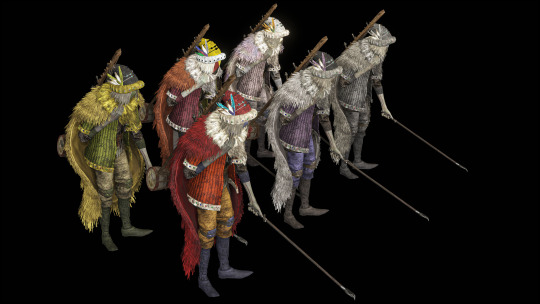
(daat at the very back in the white hat, next to malkuth)
most interestingly, "malkuth" and "da'at" are from kabbalah, the former being one of the sefirot in the tree of life, the latter being all ten sefirot being united as one. and not only is there a very prominent "tree of life" of sorts in elden ring, there's also a character called shabriri, who is named after the jewish demon of blindness and is connected to the nomadic merchants (despite a lot of content about their connection having been cut during the game's development).
what does this mean? i don't know, i just bumped into it and thought it was interesting.
46 notes
·
View notes
Text
Spoilers for visuals from the tutorial level of Tears of the Kingdom.
But I just gotta know if anyone else had thoughts about this door design:

Because with the way that it looks like the sefirot / tree of life from the kabbalah ... I'm not sure what I'm supposed to think aside from nintendo sure does like to appropriate things from a closed culture.
I understand that in Japanese the little robots are called golems while the English translation has them as the preferred constructs. So, am I supposed to think that the Zonai were Jewish? Or is it just cause our stuff is ~mystical and ~cool and they needed things to make the Zonai seem more ~otherworldly since they decided to veer away from the aesthetic they chose to hint toward the Zonai with the barbarian set in Breath of the Wild.
I mean, this design is just there, I've beaten the game and saw all the memories, though I haven't 100%'d it yet -- the design is never shown to be of any importance or do anything. So, what's the point of it? Why is it there?
#loz#tears of the kingdom#totk#totk spoilers#just visually#legend of zelda#jumblr#primarily just tagging jumblr to see if anyone else is fucking bugged by this#cause hoooo boy did it piss me off when i got here#and then you open the doors and the i-can't-believe-it's-not-christianity goddess is in the temple???#and of course i was already annoyed about the golems and green ganondorf so you can imagine how irritated I was when i got here#also if the zonai are supposed to be like fantasy jewish there are a whole mess of issues with that#but i don't feel like writing an essay right now
18 notes
·
View notes
Text
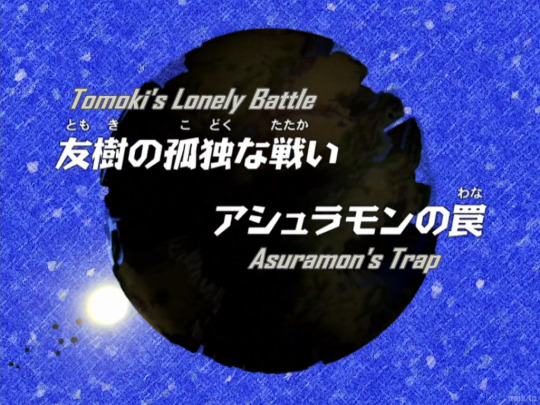
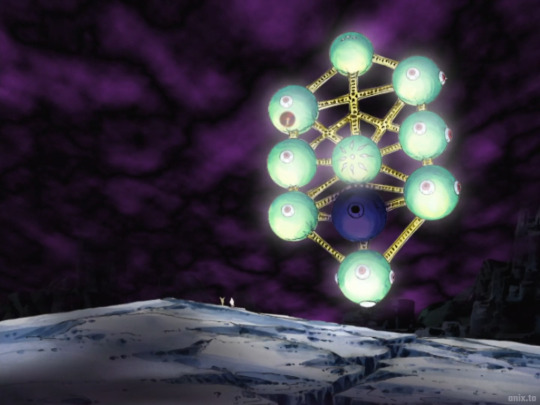
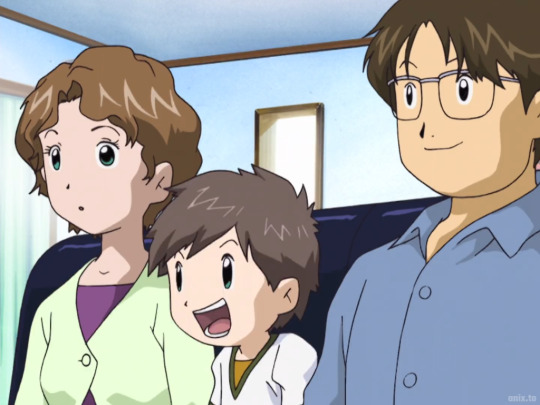


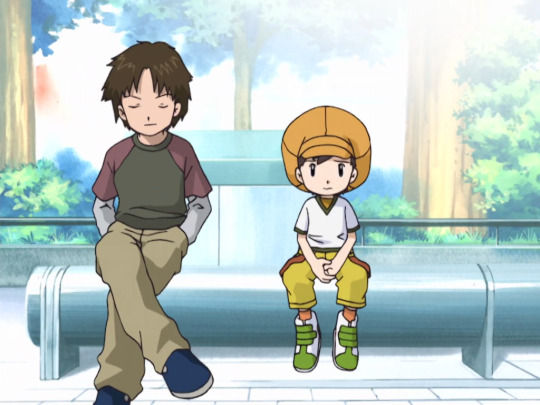
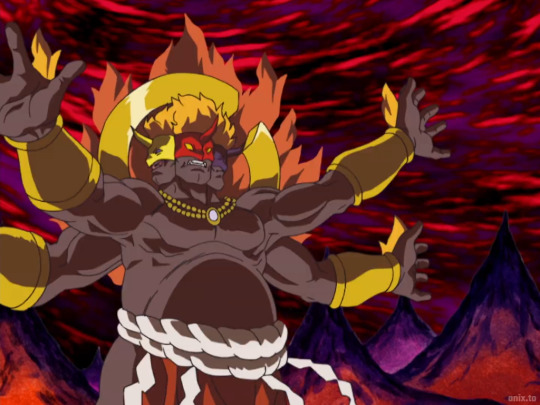
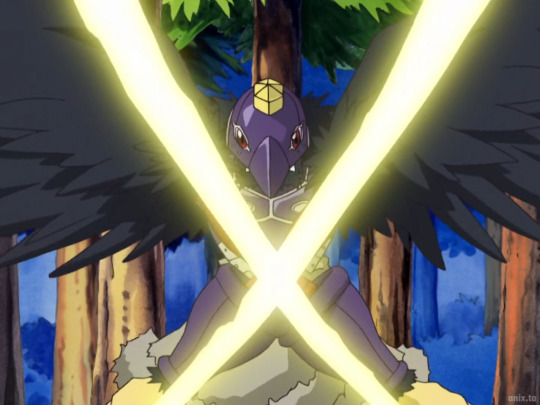
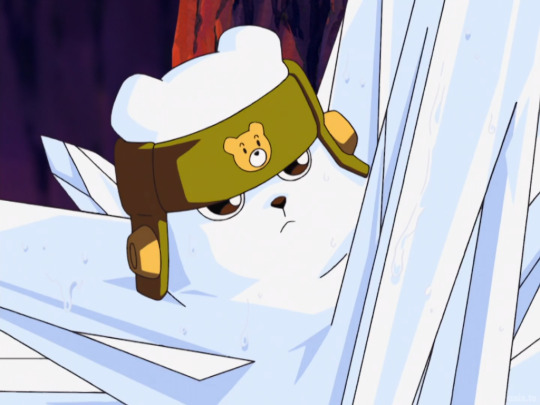

Digimon Frontier - Episode 25
Okay, now that I have a better grasp on what's happening, I was able to enjoy this one more than the last. Also, the digimon designs were a lot better this time and visuals are half the battle.
On a personal note, I had a rough day at work (coworker troubles) so seeing Tomoki's struggle with his brother being mean to him was kinda comforting in a way.
So, we learn that the giant eyeball thing is called Sephirothmon and everyone is inside of him experiencing his illusions. I really love the idea of one of the warriors being this massive, eldritch abomination. Can he communicate without sucking people in tho? Does he ever talk to the other bad guy warriors? I want to raise him in a video game lol
Aside from the other, obvious Sephiroth, I tried googling what that name means and apparently it's a term (sefirot) from Kabbalah, which I know absolutely nothing about. The wiki article kinda just hurt my brain and I gave up. I see where the visual inspo came from though.
We get to meet Tomoki's family which is always nice. His brother's kinda a hater but Tomoki comes to the revelation that he means well (I still think he's kinda an asshole lol). In the dub Tomoki says he's acting "pooey" which made me laugh.
Junpei gets his own episode but Tomoki and Koji have to share? That's kind of disappointing. I guess it's kind of interesting how their inner conflicts were juxtaposed though (Tomoki relies on people too heavily but Koji doesn't rely on others enough).
I guess Koji has mommy issues now? And Sephirothmon figured this out cuz he can read minds or something...?
Asuramon and Karatenmon have really cool designs, no notes. I guess I can add them to my mental "digimon based on mythology" chart
Asuramon tricking Tomoki felt extra unsettling because of Tomoki's age/naivety. I was really proud of Tomoki for staying strong. So far everyone's been pretty good at not falling for the BS. Respect.
There were some kind of Van Gogh-esque backgrounds in this episode that were really nice to look at.
Blizzarmon taunting Asuramon with a butt smack was amazing. (Also, is he supposed to be a yeti? I didn't realize before...)
In the preview, Izumi's inner struggle is that...she's ugly? Gimme a break 😑
5 notes
·
View notes
Text
Fragments, Factors, and Hermit's Room
NOW THAT I AM CAUGHT UP, I need to update my theories!
These were discussed and pieced together w/ saintshrine and worldexecutor! I am compiling them for my own reference.
This will contain spoilers for the remainder of the DLC, Hermit's Room, Interlude, and the Interlude and Cell of Mirage reports! AKA, everything that's been released so far.
You can find my other COE theories/analyses here!
THE FRAGMENTS
Interlude confirms there are 7 fragments, each with a number in their last name. I believe that each fragment is linked to one of the 'Seven Gifts of God', as described in a book in the Minoru DLC. Paraphrased and in order, they are:
Fear of the Lord, Piety, Fortitude, Knowledge, Counsel, Understanding, and Wisdom.
Thus, we have Hajime Hatsutori (1), Ryu Nijou (2), Teita Miwa/Dita Iliner (3), Wadachi Azuma (4), Daigo Igarashi (5), Misumi Mutsushika (6), and Izu Nanami (7).
The first three are fairly straightforward, especially with the additional descriptions in the DLC's book, but the one that interests me is Izu. In Interlude, it's mentioned that he has CLAIRVOYANCE. A Higher knowledge, and the youngest of the Fragments...
Izu also might be using the body of the original Reiji Isoi.
Mutsushika says in the Utsugi DLC that he needs a child (about 10), because he has a younger brother who can't come out into the open. Thus, he needs a vessel. He says later that the kid that Utsugi prepared is too young (four or five), but goes with it anyway.
he's talking about the little Reiji here, who's now a vessel for the 7th fragment/Izu. (credit to worldexecutor for telling me about this theory!). Is little Reiji still in there? I sure hope so, it'd be angsty ^_^
THE SEPHIRA
if you remember this cipher from Reiji DLC:

Knowing now that Seodore has the Gabriel Factor, I am operating on the assumption that this refers to Factors like his and Mutei's (Harada factor).
On the sefirot wiki page, it says this:
"The sefirot are described as channels of divine creative life force or consciousness through which the unknowable divine essence is revealed to mankind."
"Will and knowledge are corresponding somewhat dependent opposites."
I said before that I think Seodore is 'will', and Mutei is 'knowledge'. This is still true, but I think it means more than that.
I think Mutei's factor allows him to read the source code of the world. He can Know, but he can't affect or manipulate it in any way, which is in part why he's stuck in the Hermit's room. He can Know but he can't DO anything with it directly.
Seodore, on the other hand, doesn't care about understanding it. His factor can manipulate the code, but he can't read it. He just wants to find a world that isn't bound by Arrival Points, that isn't bound by the 'end of the game.' Which draws into focus: We the player are an acknowledged entity. A being that they cannot perceive, yet guides them all the same.
We have a factor of our own as well, that we receive at the end of the DLC:

The factor "Dawn" has been loaded.
Please wait for the announcement from Online Station.
This grants us access to the Hermit's Room/chapter select screen, which is interesting and something I need to think more about! HOWEVER. I want to talk about THE LANTERN.
THE LANTERN
At the end of Hermit's Room, we have this:
"The Record Da'at_01 has been saved. Subsequent playback is by the system."

as well as 'Do not trust Mutei Harada."

I looked up Da'at, and found this on the wikipedia page:
In Daʻat, all sefirot exist in their perfected state of infinite sharing. The three sefirot of the left column that would receive and conceal the Divine light, instead share and reveal it. Since all sefirot radiate infinitely self-giving Divine Light, it is no longer possible to distinguish one sefira from another; thus they are one. Properly, the Divine Light is always shining, but not all humans can see it.
I think THIS is what the lantern on the table is. The lantern is the condensed form of every factor at once, which is why it is able to give Mutei a presence in this room. I believe this is ALSO the light seen at the end of the S route, the three rings. By coming to this room, we have Arrived at a place beyond the typical bounds of the game. I think it's the Primum Mobile, the Ninth Heaven of the Divine Comedy. We the player are generally acting from the 10th, in Empyrean Heaven (beyond the bounds of the game), while Hermits Room/the Domain that lets Atou and Seodore tweak the definitions of the world is the Primum Mobile.
Similarly, this is what gives us the chapter select screen as well. Time works differently for us vs the characters.
One Final Cipher:
At the end of the DLC, we are presented with these:


e7a59e is the Hexadecimal code for 神, aka GOD. I'm not entirely sure what the characters in front of it say (my google translate says 'draft' for the first, and 're-edited' for the second). If anyone has a more accurate translation, please let me know!
Assuming that the MTL is correct, then the 'draft' of the world is by God, and the 're-written' version is by CODE:DANTE.
CODE:DANTE seems to be at odds with Mutei. I'm operating on the assumption that they're a part of Seodore's group? Kanou is a part of this group too...
MUTEI (bastard)
There is one bit in particular I want to bring up in the Interlude Reports. Specifically, CodeData 05-2. He comments (paraphrasing) that if he were God, he'd want to collect all the different outcomes and endings of his world, and that he'd want the protagonist to oppose him and make a possibility he could never have imagined.
....Seodore's already had his turn guiding/influencing a protagonist. I suspect that in Cell of Mirage, it will be Mutei trying to pull the strings. Or rather, I think he's hoping to pull OUR (the player) strings in the hope that we can influence the world (and rui lmao) for him. He does bring up in Hermit's room that he'd like us to apologize to seodore for him, if we can gain access to the world he thought was gone.... Either he's being honest about that apology OR he's doing it as a test to see if we can change the world for him.
Is it possible for a character to resist the player? Can the characters within a story break free of the definitions that Bind them? What is fiction, what is reality, and how does the world within these frames challenge that? I believe that this will be central to Cell of Mirage and it's themes.
also, side tangent, but I think it's fascinating how much Mutei parallels us as the player. I need to think more on this but I absolutely think something is there. Mans wants to play god and I think he doesn't care about the consequences. I need to think about him and seo and rangiri more...
once again, this image is relevant. Mutei Harada is a LITTLE SHIT.
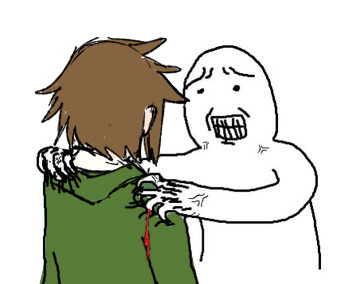
Cell of Mirage and Interlude
I will be referencing this translation by fleecedragon! please read through it!
I think that Miwa and Eigha are aware of what's to come/their true natures, and Dita and Takagi don't. In interlude, Eigha says several things that seem to imply that he is aware that he is a fictional character, playing a role that he cannot escape.
I THINK HE KNOWS. HE KNOWS THAT HE IS FICTIONAL, and the world will end when the game does. There is nothing beyond the 'Arrival point', so the only way to preserve this world is to never finish the game.
Dita isn't aware of Miwa/Miwa's memories, so I think he's gonna have a GREAT time after he learns that he's fictional ^_^ I want to see Dita have a mental breakdown ^_^
Also I'm pretty sure the fourth wall just doesn't exist for Gajura, as he talks directly to us in his character profile.
#cell of empireo#細胞神曲#세포신곡#CellOfEmpireo#aria rambles#aria's analysis#coe spoilers#coe meta#coe theory#gavi no clicky#all spoilers shooould be under the cut#coe dlc spoilers#coe interlude spoilers#coe hermit's room spoilers#cell of mirage#not tagging characters bc. this is analysis focused but not character centric lmao
34 notes
·
View notes
Note
I fear I might have bought something appropriating Judaism without knowing. It's a Tarot game that I learnt months after purchasing it is inspired by Marseille tarot, Kabbalistic teachings and Esoteric wisdom. I didn't unbox it before since I wanted to treasure it. The game incorporates The Sefira, Keter, and Da'at. I was blinded by the lgtbqa+ friendly and diverse art of the deck itself and didn't research the name sefirot before becoming part of kickstarter for it since I only linked it to Angel Sanctuary where I'm now also wondering about the manga being culturally appropriating? When I read it as a child I thought it featured Christian lore which I know next to nothing about. Would you mind talking about this game a little bit so that others who are as uneducated, naive, or thoughtless know what's up.
Oops! It happens lol. One thing you can do is check if the artist/designer is Jewish, but yeah it's a little dicey.
I'm not familiar with the manga so I can't speak on it, but in general I think it's important to distinguish games/works of fiction from appropriating actual hands-on practice. It's fine for things to inspire things so long as they're being respectful of the source material and aren't using it in an offensive/disrespectful manner, or the artist isn't directly exploiting it for profit that the culture never benefits from (as opposed to just lil motifs or something.)
Reading a manga doesn't make you a bad person or anything though, just recognize it and digest media mindfully.
If the deck makes you uncomfortable though you could sell it and donate the proceeds or give it to a Jewish person ^^
24 notes
·
View notes